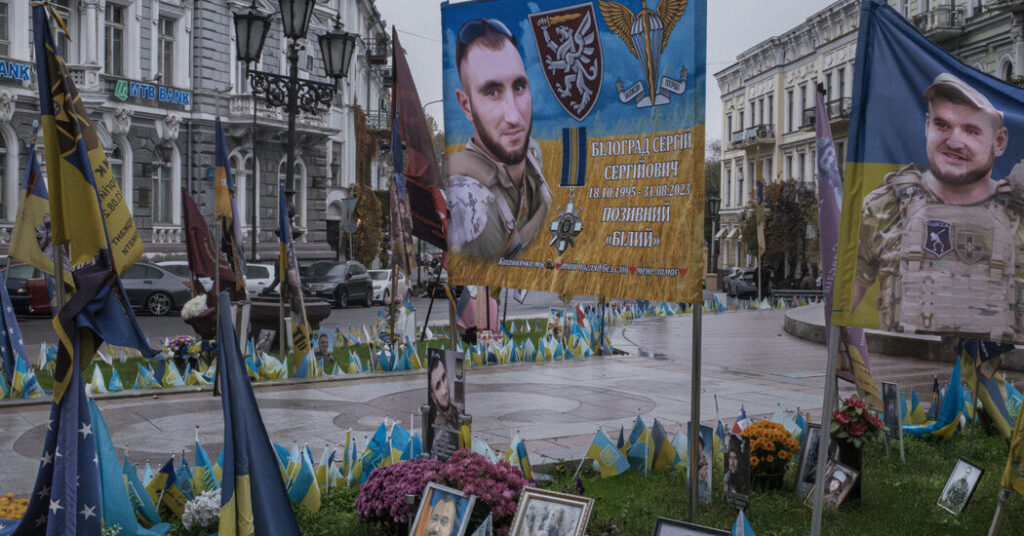European Union officials have spent months focused on a plan to use frozen Russian assets to make a loan to Ukraine that could help Kyiv fight the next phase of the war.
It is increasingly clear that the bloc has nothing but bad alternatives should that fail.
The loan plan, through which the European Union would use Russia’s central bank assets in Belgium to funnel 140 billion euros, or about $160 billion, to Ukraine, was expected to move forward at the bloc’s political meeting last month. Instead, in a last-minute surprise, Belgium blocked it.
Belgian officials say they are worried that the nation could be on the hook should Russia file a lawsuit or demand its money back. To mitigate that risk, they are asking that other European nations firmly commit to taking on some of the burden through guarantees, a suggestion that has met with pushback from Slovakia. They have also been pressing the European Commission, the bloc’s executive arm, to consider other options for getting money to Ukraine.
The commission set out those alternatives in a letter sent to national capitals on Monday and seen by The New York Times. One option would be for the European Union to issue joint debt to raise the money Ukraine needs. Another would be for individual member states to give Ukraine direct grants. But both have problems. Joint borrowing would be expensive, entailing interest costs, and direct grants would strain the budgets of already-indebted nations.
Given that, policymakers, diplomats and outside experts in Brussels often voice confidence that the frozen asset loan plan will come together — not because it is without complications, but because the backups are so unattractive at a moment when so much is at stake.
“What is clear is that Plan B is less good than Plan A,” said Nicolas Véron, who co-founded the economic research organization Bruegel in Brussels and who is also at the Peterson Institute for International Economics in Washington. “Is not giving money to Ukraine an option? The answer is no.”
Ursula von der Leyen, the president of the commission, said last week that while the other two options exist, the loan using the frozen assets “is the most effective way to sustain Ukraine’s defense and its economy.”
The frozen asset loan plan offers advantages. The bloc would be able to make Ukraine a zero-interest loan that would need to be paid back only if Russia paid reparations. It would also allow for a big, headline-grabbing cash infusion that would demonstrate to the Kremlin that Ukraine has the funding to get through the war.
Not only would the alternatives prove more financially stressful, but they would most likely involve only smaller and more incremental flows of cash to Ukraine.
If the European Union had to use one of those other options, “it would reinforce the perception in Putin’s mind that time is on his side,” said Mujtaba Rahman, managing director for Europe at the Eurasia Group, a political risk consultancy.
But some E.U. countries have been reluctant to offer the kind of reassurance that Belgium is looking for to accept the frozen asset loan plan. Prime Minister Robert Fico of Slovakia has warned that his country would oppose such a setup if the money is used for military costs.
Russia issued another warning in state media last week that it could come after Belgium if the assets were seized. While E.U. officials have made it clear that they do not see making a loan against the assets as a seizure, Russia does not recognize that distinction.
Even the European Commission acknowledged in its letter on Monday that there is a risk that the frozen asset loan would be “incorrectly perceived” as a confiscation of Russia’s savings — a move that could worry international investors who keep money in Europe.
Still, the commission also warned against a “search for perfect or simple solutions which do not exist.”
Time to reach an agreement could be running low. The International Monetary Fund has estimated that Ukraine’s budget gap is around $65 billion for 2026 and 2027, based on reporting from Bloomberg News.
E.U. officials regularly suggest that Ukraine will need a new cash infusion by March or April. But it is unclear whether they can get for an agreement by the time bloc political leaders meet next on Dec. 18.
If a loan takes too long, Valdis Dombrovskis, the European economy commissioner, has suggested that the bloc may need to consider solutions to bridge a funding gap in the spring. The commission’s letter this week suggested that the options could be combined, or even used temporarily, to make sure that money gets to Ukraine in time.
Matters have been complicated further by Belgium’s domestic political situation. Prime Minister Bart De Wever’s government has struggled for months to pass a budget, and it is possible the governing coalition will collapse if a deal is not reached by the end of December.
Some in the bloc are hoping for an outside boost that will make the loan plan more palatable. Norway, which is not in the European Union but which is closely tied to it economically, has benefited financially from the war as energy prices — and the resource-endowed nation’s revenues — have shot up. Given that, two Norwegian economists have argued that the country should help to guarantee the E.U. loan.
“What use would our sovereign wealth fund be to future generations if we lived in bondage to Russia?” said Knut Anton Mork, one of the economists.
Norwegian lawmakers are open to the idea. But the country would not want to be a sole guarantor on the frozen asset loan, Jens Stoltenberg, the Norwegian finance minister, said last week.
The upshot? European leaders are in for weeks of fierce negotiation as they try to make the asset plan come through — and face serious risks if they cannot.
Jeanna Smialek is the Brussels bureau chief for The Times.
The post With Ukraine’s Cash Running Low, Europe Lacks a Good Plan B appeared first on New York Times.




